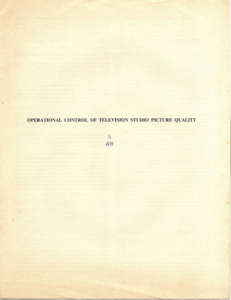Vision Control operation sought to ensure sure that the images from each of the studio cameras matched – and in particular, to make sure that the facial tones from each camera matched.
On the Stagger Through (now “Blocking”?), the VC operator did absolutely nothing. In fact, this was in the Job Description (not simply dossing about). All the controls were put into the middle of their travel at the start of the Stagger, and then left completely alone. The idea was that the senior lighting engineer, Lighting Director (or TM1 as they later became) should light the scene such that the images from each camera matched – one angle was not hopelessly in shadow, for example.
Then, during the run throughs, the Vision Control operator could start tweaking the controls a little.
Then came Transmission! The Vision Control Operator had a control for each camera (and the spare) so that was six controls in TC3 and TC4. There were also similar controls for 2 VT machines and 2 TK machines – 10 main controls and gamma correction – and two hands, constantly matching outputs!
See also: In the Gallery
 |
Operational Control of Television Studio Picture Quality |
This reprint outlines the operational procedures used in B.B.C. television studios for the control of television-studio picture quality, and discusses briefly the factors upon which the new techniques are based. There appears to be wide agreement that the pictures produced by modern equipment operated as described in the paper are consistent and of good technical quality. Also, application of the techniques has resulted in staff economies, and it would seem logical that the lighting and vision control functions of television operations should completely merge, as equipment design and operational techniques progress.
|
Back to top
Back to reprint index



